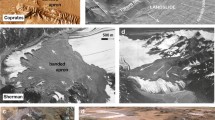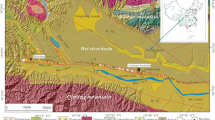Summary
Mechanisms of Large Landslides
The moving components of many large landslides show a remarkable tendency to remain in more or less undisturbed sequential order. In the present study this lack of laminar or turbulent flow is mathematically analyzed and explained. The high energy concentration thus resulting for the zone near the gliding surfaces points to self-lubrication by transformed (fused or dissociated) rock as a fundamental tribological mechanism. The idea is backed by two important facts: the impossibility to explain the observed economy of locomotion (and especially its increase with size) by any of the mechanisms considered hitherto; and a calculation yielding an unexpectedly low amount of energy susceptible to be dissipated far away from the gliding surfaces. Further analysis demonstrates numerically the plausibility of the self-lubrication concept both for primitive and carbonate rock. The development of useful prediction algorithms is not impossible in the future.
Zusammenfassung
Mechanismen groβer Bergstürze
Die Trümmerströme vieler großer Bergstürze zeigen eine bemerkenswerte Tendenz zum Verbleiben in mehr oder weniger undurchmischtem Verband. In der vorliegenden Arbeit wird dieses Fehlen laminarer oder turbulenter Strömung auf Grund einer mathematischen Untersuchung erklärt. Die dabei resultierende hohe Energiedichte in der Nähe der Gleitflächen deutet auf Selbstschmierung durch transformiertes (geschmolzenes oder dissoziiertes) Gestein als entscheidenden tribologischen Mechanismus. Zwei wesentliche Tatsachen sprechen für diese Idee: das Versagen aller bisher vorgeschlagenen Mechanismen bei der Erklärung der beobachteten Bewegungsökonomie, speziell im Hinblick auf deren Steigerung in Funktion der Größe; und der rechnerisch ermittelte überraschend niedrige Energieanteil, der in größerer Entfernung von den Gleitflächen umgesetzt werden kann. Eine weitere Rechnung demonstriert zahlenmäßig die Plausibilität der Selbstschmierung sowohl für Urgesteine wie für Kalke. Die Entwicklung brauchbarer Vorhersage-Algorithmen rückt damit in den Bereich des Möglichen.
Résumé
Les mécanismes de gros éboulements
Les composantes de gros éboulements montrent une tendance remarquable à se déplacer dans un ordre plus ou moins invariable. L'étude explique mathématiquement cette absence d'écoulements laminaire ou turbulant. La haute concentration d'énergie aux environs immédiats des surfaces de glissement implique la possibilité d'une auto-lubrification par le rocher métamorphosé (soit fondu, soit dissocié) en tant que mécanisme tribologique fondamental. Deux faits importants appuient cette hypothèse: d'une part l'impossibilité jusqu'à maintenant d'expliquer l'économie d'énergie observée (et spécialement en corrélation avec la grandeur de l'évènement) par un mécanisme quelconque; d'autre part la fraction d'énergie déterminée par calcul, étonnament basse, susceptible d'être métamorphosée à grande distance des surfaces de glissement. En outre le calcul démontre la possibilité du mécanisme d'auto-lubrification pour les plus importants types de rochers (primitifs et sédimentaires). Le développement futur d'algorithmes de prédiction utilisables entre de ce fait dans le domaine du possible.
Similar content being viewed by others
Abbreviations
- a :
-
acceleration (m/s2)
- A :
-
area (m2)
- c :
-
specific heat (J/kg °C)
- C :
-
transformation heat (J/kg)
- d :
-
distance between two narrow passages (m)
- e :
-
base of natural logarithms = 2.72
- e :
-
thickness of layer (m)
- g :
-
gravitational acceleration = 9.81 m/s2
- h :
-
thickness of mass (m)
- k :
-
resistance coefficient
- L :
-
global coefficient describing tribological quality (m/s4)
- m :
-
mass (kg)
- M :
-
lubrication quality factor
- p :
-
pressure (Pa)
- P :
-
power (W)
- r :
-
wave amplitude (m)
- s :
-
air cushion or gap thickness (m)
- t :
-
time (s)
- v :
-
velocity, speed (m/s)
- V :
-
volume (m3)
- W :
-
specific energy (J/kg)
- x :
-
distance travelled (m)
- z :
-
height (m)
- Z :
-
height of center of gravity (m)
- α :
-
slope angle
- β :
-
relative portion of volume occupied by voids
- δ :
-
dissipation coefficient
- Δ :
-
difference
- ε :
-
relative fraction of A acting as narrow passage
- ζ :
-
depth (m)
- ŋ :
-
viscosity (kg/ms)
- θ :
-
temperature (°C)
- ϰ:
-
adiabatic constant of air = 1.4
- λ :
-
wavelength (m)
- µ :
-
coefficient of friction (solid state)
- \(\bar \mu \) :
-
average coefficient of friction
- π :
-
Ludolf's number = 3.14
- ϱ :
-
density (kg/m3)
- φ :
-
fidelity coefficient
- ψ :
-
jet contraction factor
- a :
-
primitive rock
- A :
-
air cushion
- b :
-
feldspar
- c :
-
quartz
- d :
-
lubricant generated from primitive rock
- d :
-
dissipation
- e :
-
sedimentary rock
- E :
-
air escape gap
- f :
-
CaO
- g :
-
CO2
- h :
-
lubricant generated from sedimentary rock
- i :
-
ordinal number
- L :
-
lubricant
- M :
-
total area
- R :
-
rock
- o :
-
initial, basic, 30 = after 30 s
References
Bagnold, R. A.: Experiments on a Gravity-Free Dispersion of Large Solid Spheres in a Newton Fluid Under Shear. Proc. R. Soc. Lond.A 225 49–63 (1954).
Bagnold, R. A.: The Flow of Cohesionless Grains in Fluids. Proc. R. Soc. Lond.A 249 235–297 (1955).
Braddock, W. A.: Dakota Group Rockslides, Northern Front Range, Colorado, U. S. A. In: Rockslides and Avalanches, 1 (Voight, B., ed.). Dev. Geotech. Eng. 14 A. pp. 439–479. Amsterdam, Oxord, New York: Elsevier. 1978.
Erismann, T. H.: Der Bimsstein von Köfels, Impaktit oder Friktionit? Mat. und Techn.5 190–196 (1977).
Erismann, T. H., Heuberger, H., Preuss, E.: Der Bimsstein von Köfels (Tirol), ein Bergsturz-„Friktionit“. TMPM24 67–119 (1977).
Goguel, J.: Le róle de l'eau et de la chaleur dans les phénomènes tectoniques. Rev. Géogr. Phys. et Géol. Dyn.2 153–163 (1969).
Goguel, J.: Scale-Dependent Rockslide Mechanisms, with Emphasis on the Role of Pore Fluid Vaporization. In: Rockslides and Avalanches, 1 (Voight, B. ed.). Dev. Geotech. Eng. 14 A. pp. 693–705. Amsterdam, Oxford, New York: Elsevier. 1978.
Habib, P.: Sur un mode de glissement de massifs rocheux. C. R. Acad. Sc. Paris264/Serie A, 151–153 (1967).
Heim, A.: Bergsturz und Menschenleben. Zürich: Fretz & Wasmuth. 1932.
Hsü, K. J.: Catastrophic Debris Streams Generated by Rockfalls. Geol. Soc. Amer. Bull.86 129–140 (1975).
Hsü, K. J.: Albert Heim: Observations on Landslides and Relevance to Modern Interpretations. In: Rockslides and Avalanches, 1 (Voight, B., ed.). Dev. Geotech. Eng. 14 A. pp. 71–93. Amsterdam, Oxford, New York: Elsevier. 1978.
Hubbert, M. K., Rubey, W.: Role of Fluid Pressure in Mechanics of Overthrust Faulting. Bull. Geol. Soc. Amer.70 115–166, 167–206 (1959).
Kent, P. E.: The Transport Mechanism in Catastrophic Rock Falls. Journ. Geol.74 79–83 (1965).
Körner, H. J.: Reichweite und Geschwindigkeit von Bergstürzen und Fließschneelawinen. Rock Mech.8 225–256 (1976).
Körner, H. J.: Flow Mechanisms and Resistances in the Debris Streams of Rock Falls, Bull. Internat. Ass. Eng. Geol.16 101–104 (1977).
Kurat, G., Richter, W.: Impaktite von Köfels, Tirol. TMPM17 23–45 (1972).
Masch, L., Preuss, E.: Rocks and Rock Formation in an Example of Frictional Fusion on a Thrust Plane in the Langtang Himal, Nepal. IMA-Meeting 1974. Collected Abstracts, 193, 1974.
McKenzie, D., Brune, J. N.: Melting on Fault Planes During Large Earthquakes. Geophys. J. R. astr. Soc.26 65–78 (1972).
Müller, L.: The Rock Slide in the Vaiont Valley. Rock Mech. and Engin. Geol.2 148–211 (1964).
Pichler, A.: Zur Geognosie Tirols. II. Die vulcanischen Reste von Köfels. Jb. K. K. Geol. Reichsanst. (Vienna)13 591–594 (1863).
Pierce, W. G.: Principal Features of the Heart Mountain Fault and the Mechanism Problem. In: Gravity and Tectonics (DeJong, K. A., Scholten, R., eds.). pp. 457–471. New York, Chichester: John Wiley & Sons. 1973.
Plafker, G., Ericksen, G. E.: Nevados Huascaran Avalanches, Peru. In: Rockslides and Avalanches, 1 (Voight, B., ed.). Dev. Geotech. Eng. 14 A. pp. 277–315. Amsterdam, Oxford, New York: Elsevier. 1978.
Preuss, E.: Über den Bimsstein von Köfels/Tirol. Fortschr. Min. 49, Beiheft1 70 (1971).
Scheller, E.: Geophysikalische Untersuchungen zum Problem des Taminser Bergsturzes. Doctorate's thesis ETH, Zürich, pp. 54–76, 1970.
Shreve, R. L.: The Blackhawk Landslide. Univ. Calif. Special Paper No. 108, 1968 a.
Shreve, R. L.: Leakage and Fluidization in Air-Layer Lubricated Avalanches. Geol. Soc. Amer. Bull.79 653–658 (1968 b).
Stutzer, O.: Die Talweitung von Köfels im Ötztal (Tirol) als Meteorkrater. Zeitschr. Deutsch. Geol. Ges.88 523–525 (1937).
Suess, F. E.: Der Meteor-Krater von Köfels bei Umhausen im Ötztale, Tirol. N. Jb. Min., Geol. und Paläont., Abh. 72, Beilage-Bd. Abt. A. 98–155 (1937).
Voellmy, A.: Über die Zerstörungskraft von Lawinen. Schweiz. Bauzeitung73 159–165, 212–217, 246–249, 280–285 (1955).
Welsch, W., Kinzl, H.: Der Gletschersturz von Huascaran (Peru) am 31. Mai 1970. Zeitschr. Gletscherk. u. Glaz.-geol.6 1–2, 181–192 (1970).
Wyllie, P. J., Tuttle, O. F.: The System CaO-CO2-H2O and the Origin of Carbonatites. Journ. Petrol.1 Part 1, 1–46 (1960).
Author information
Authors and Affiliations
Additional information
With 12 Figures
Rights and permissions
About this article
Cite this article
Erismann, T.H. Mechanisms of large landslides. Rock Mechanics 12, 15–46 (1979). https://doi.org/10.1007/BF01241087
Received:
Issue Date:
DOI: https://doi.org/10.1007/BF01241087




